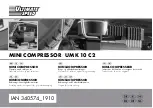
9
HP01P006SS man v.170807
Silent Air Series
DO NOT over-tighten the air filter.
3.
Be sure the short length of flexible hose is
inserted into the hole in the air filter housing. This
increases the noise-reduction capabilities of your
compressor.
Operation
Before operating your new air compressor:
●
Inspect for damage before using the air
compressor, make sure the air tank is not
damaged, inspect all parts for damage, and
check that all pipes and hoses are firmly
connected.
●
Do not use the air compressor if any damage is
found. If damaged, have an authorized service
center inspect and test the air compressor to
ensure that is working properly.
●
Pull the ring on the safety valve before each use
to make sure the valve is functional.
●
Depending on the CFM draw of the tools being
operated, your new air compressor can be used
for operating paint sprayers, air tools, grease
guns, airbrushes, caulking guns, abrasive
blasters, tire & plastic toy inflation, spraying
weed killer and insecticides, etc. Proper
adjustment of the air pressure regulator is
necessary for all of these operations. Refer to
the air pressure specifications provided with the
tool you are using.
General Overview
Installation and Location
Locate the compressor in a clean, dry and well
ventilated area. The compressor should be located
12 to 18 inches (30 to 45 cm) from walls or any
other obstruction which would interfere with airflow.
Compressor should be located in a temperature-
controlled area between 32° and 95° fahrenheit
(0 ° and 35 °C). Place the compressor on a firm,
level surface. The compressor is designed with heat
dissipation fins which allow for proper cooling. Keep
the fins (and all other parts which collect dust or dirt)
clean. A clean compressor runs cooler and provides
longer service. Do not place rags, containers or other
material on top of the compressor.
Connecting to Power Source
This air compressor is designed to operate on a
properly grounded 120 volt, 60 Hz, single phase,
alternating current (AC) power source with a fused
20 amp time-delayed fuse or circuit breaker. It is
recommended that a qualified electrician verify the
ACTUAL VOLTAGE at the receptacle into which the
unit will be plugged and confirm that the receptacle is
properly fused and grounded. The use of the proper
circuit size can eliminate nuisance circuit breaker
tripping while operating your air compressor.
Extension Cords
●
For optimum air compressor performance an
extension cord should not be used unless
absolutely necessary.
●
If you must choose between an electrical
extension cord and a longer air hose, choose
the latter. It is far better for the life of the
compressor. If necessary, care must be taken in
selecting an extension cord appropriate for use
with your specific air compressor.
●
Use a heavy-gauge extension, since very thin
or very long cord may cause voltage drop
and result in loss of power in the compressor
and overheating. Select a properly grounded
extension cord which will mate directly with
the power source receptacle and the air
compressor power cord without the use of
adapters. Make certain that the extension
cord is properly wired and in good electrical
condition.
●
Maximum length of extension cord should be
50 feet (15 meters). Minimum wire size of
extension cord should be 12 gauge.
Attaching an air hose
Your air compressor is supplied with a 1/4" push-
connect air coupler (fig 3). With a factory installed
air coupler, your compressor is ready to accept air
hoses equipped with 1/4" male air connectors (fig 4).
Use only air hoses rated for use
with 115 psi air pressure or
higher.
To install an air hose equipped with a 1/4" male
connector (fig 3)
:
1.
Simply push the "connector" or "plug" into the
fitting (fig 4) and it automatically engages.
2. Verify that air hose is securely connected to air
coupler by pulling on the air hose.
fig 3
fig 4
































